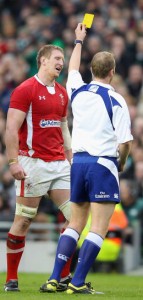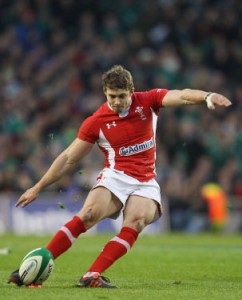
Centre point: Jonathan Davies, who ran great attacking lines against Ireland, scores his second try in Dublin
By Paul Williams
WALES BEAT Ireland 23-21 in Dublin on Sunday in their opening Six Nations fixture, but what did we learn about the men in red? Here’s the lowdown on the good, and not so good, of their performance – and stay tuned for more Welsh analysis throughout the rest of the championship.
1. Welsh back-line makes a big impression
Even by modern standards, Wales have assembled an enormous back-line and they dominated the Irish threequarters in a manner rarely seen in Tier One Test rugby. But this wasn’t the barrage of the ten channel that has historically welcomed Ronan O’Gara. The selection of the defensively sound Sexton and the absence of O’Driscoll meant that Wales targeted the 12/13 channel instead – and with enormous success. Jamie Roberts’s inside angles were destructive and Jonathan Davies’s blend of inside-out and outside-in attacking lines led him to top the try count and ball-carrying stats for both teams (two tries/64m). It meant that the comparatively diminutive centre partnership of Gordon D’Arcy and Fergus McFadden had to make 26 tackles between them, whereas Roberts and Davies made a miserly 12. But whilst the Welsh centre pairing may have dominated midfield, George North was, at times, unplayable. Whether he is running hard, direct lines or more subtle diagonals, North is beginning to embarrass some of the biggest names in rugby. Lions Jamie Heaslip and Rob Kearney were both dispensed with during North’s early touchline burst, but it was the manner in which he dismissed Fergus McFadden that produced the game’s ‘YouTube moment’.
2. Never rule out Ryan Jones
Ryan Jones may no longer be the fulcrum of the Welsh team, but he played a vital role against the Irish. Jones doesn’t possess Dan Lydiate’s technical proficiency, which brought O’Brien, Ferris and Heaslip down to earth in the World Cup, but he is an organised and relentless defender – he was Wales’ third highest tackler with 11. But it is Jones’s ball-carrying that is most valuable to Wales. Whilst he rarely makes the 30-yard runs through the ten channel (the sort that close out Six Nations highlights programmes), it is his persistent five-yard carries in the narrow channels that are so beneficial to Wales. Jones’s heavy and belligerent ball-carrying not only sucks in more guards to the ruck area, it also allows Toby Faletau more freedom to sit wide (and create the sort of breaks that will, at some stage, close out a Six Nations highlights programme).
3. Wales must remember that rugby is a 15-man game
Tip tackles lose you matches. Having lost a World Cup semi-final for that very reason, you wouldn’t think the Welsh team need reminding that they shouldn’t lift players ‘above the horizontal’. That’s why Bradley Davies’s decision to upend Donnacha Ryan was unfathomable. It was negligent on so many levels. Davies’s decision reduced Wales to 14 men and created extra gaps in a defensive line that had played 65 minutes of intense rugby. Ten minutes in the bin also reduced Wales’ options in an already failing lineout. This will have implications beyond the game in Dublin, a citing is certainly in the post and will further deplete Gatland’s second-row options – he is already without Alun Wyn Jones and Luke Charteris. But above all the incident was malicious, genuinely dangerous and a sizable ban is sure to follow.
4. The Welsh lineout is broken
Wales won in Ireland despite their lineout. What was once deemed an Achilles heel is beginning to resemble a compound fracture. Wales had a lineout completion rate of 71.4% on Sunday (W10, L4) – the worst lineout completion percentage of the opening weekend of Six Nations fixtures. It simply isn’t good enough. Wales’ first lineout saw Huw Bennett throw a tricky, five-yard short ball to the first jumper. Whilst this unorthodox move brought a cheer from the crowd, it spoke volumes about Wales’ lack of confidence in their ability to secure possession. Much has been made of the injuries to Gethin Jenkins, Matthew Rees and Dan Lydiate, but Luke Charteris’s absence is arguably the most damaging.
5. Goalkicking wins games
If Wales had lost in Dublin on Sunday, it would have been yet another defeat that the Welsh management could justifiably put down to poor goalkicking. Wales had a success rate of just 42.95% in Dublin which is well below the requisite 75/85% demanded at Test level. Whilst Rhys Priestland’s goalkicking is notoriously temperamental, even he must have been surprised when he missed a 22m tiddler from in front of the posts. You could hear the words “I could have kicked that” echoing around Wales, and for once they were right. With so many scrum offences resulting in knee-jerk penalty decisions, Warren Gatland needs to consider whether Leigh Halfpenny should be given the kicking tee for the rest of the tournament.
What did you make of Wales’ performance? Let us know your thoughts by using the comment box below.







